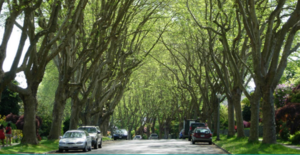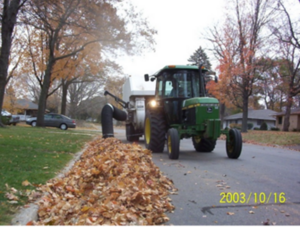
Recommended practices for a water quality-targeted street sweeping program
This fact sheet provides a summary of practices you can consider when implementing an enhanced street sweeping program for managing phosphorus loads to lakes, rivers, streams, and wetlands. Not all these practices can or should be implemented. Instead, select practices based on human and financial resources available, the physical characteristics of your area, and the feasibility of implementing each practice (e.g., consider exiting ordinances, likelihood of public acceptance).
How do I prioritize where to sweep?
- Identify watersheds with phosphorus or sediment impairments and target streets in these areas for sweeping.
- Identify and prioritize sweeping in areas of high tree canopy cover.
What practices should I consider implementing?
- In areas with significant tree canopy, time spring and fall sweeping events to occur during and after blossoms, fruit and leaves drop and consider multiple passes to capture materials, as these will continue to drop over a period of weeks.
- Time sweeping to capture organics prior to significant rainfall events to avoid wash-off and leaching to stormwater.
- Consider sweeping during the summer, and winter (as practical) to capture other sediment and debris and lingering vegetative matter.
- Consider investing in a high efficiency sweeper to capture more of the smaller street dirt particles, which have been shown to have higher phosphorus concentrations.
- Use high efficiency and broom sweepers in tandem, with broom sweepers picking up the bulk of the material followed by a high efficiency sweeper to remove smaller particles.
Are there other tools or resources I should utilize?
- Conduct a tree inventory and store the data in a Geographic Information System (GIS).
- Collect and store data related to sweeping practices and material collected.
- Utilize GIS and Global Positioning System (GPS) technology to track and record information.
- Develop ordinances to facilitate leaf collection during fall leaf drop. Examples include parking restrictions and encouraging residents to rake boulevard leaves into a street the day prior to sweeping and prohibiting this activity at other times.
- Conduct outreach and education to inform citizens of the importance of street sweeping. As an example, see this educational video by the City of Bloomington.
- Once you have developed an enhanced sweeping program, enact ordinances that promote and protect trees on public streets and, to the extent possible, on private property. For more information, see Trees in the City (PAS Report 236).
Where can I learn more?
- MN Stormwater Manual – Recommended street sweeping practices for water quality purposes
- MN Stormwater Manual - Case studies for street sweeping
- San Diego Street Sweeping Pilot Studies
- Street Sweeping – Report No. 3: Policy Development and Future Implementation Options for Water Quality Improvement
- Contrary to Conventional Wisdom, Street Sweeping Can be an Effective BMP

